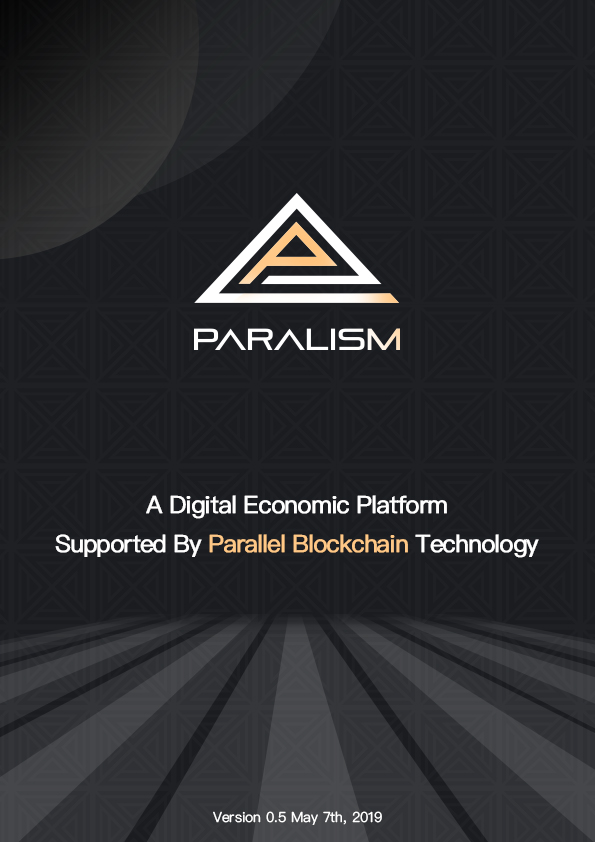Abstract
Paralism is an ecological infrastructure for digital economy powered by parallel blockchain technology. On top of Hyperchain technology with high performance and unlimited scalability, Paralism fulfilled the platform adding features such as DPoW and dynamic sharding. It acquired more application applicable attributes such as business irrelevant, concurrent operation, template based deployment, and cross-chain inter-operation, thus showing strong business adaptability. The direct effects to the application layer drawn from the above include the independent and interactive operation of multiple businesses, operation of virtual chains, none-intermediary asset exchange, etc., which further provides technical feasibility for self-coinage, decentralized exchange, stable coin market, and swap between physical and digital assets.Paralism combines the advantages of both public blockchain and consortium blockchain. This revolutionary change allows users to have the full benefits of blockchain technology without compromising. Meanwhile, The isolation and disconnection due to the sequential data structure of traditional blockchain will be completely solved.
Content
2.2 Definition of Interconnection of Value
2.4.3 Dynamic Sharding Algorithm
2.4.5 Analysis of Consistency Consensus
2.5 Technical Characteristics and Advantages
4 Operation of Node and Application Deployment
4.1 Initialization and Node Establishment
4.1.1 Initialization and Node Establishment
4.1.2 Consensus and Cheat Prevention
4.1.3 Data Submission and Query
4.3 RDapp (Rapid Decentralized App)
4.4 Inter-operation And Decentralized Trade
1 Instruction
1.1 What is Paralism ?
Paralism is the digital economic operation platform powered by parallel blockchain technology with following features:
- Highly open,fully decentralized parallel digital economic infrastructure;
- High performance, high concurrency, co-existence of multi-cryptos and multi-services
- The business on chain is completely autonomous and highly customizable.
- Capacity,load and supported business categories of the chain can be dynamically expanded and infinitely scalable.
- Support more business types, coinage, DApp, shared ledger, tokenization, stable currency , traditional finance, prediction market, etc.
- Built-in cross-chain interaction ability, the business and assets on the chain can operate both independently and seamlessly interactively;
Based on the Hyperchain parallel blockchain technology [1], Paralism breaks through the three limitations of the traditional blockchain: load capacity crisis, scalability crisis, chain interaction crisis [2-5], while retaining the complete blockchain characteristics. Paralism reinforces the dynamic loadability of Hyperchain and designs an economic model for parallel systems. Driven by the new economic model, Paralism can support both cryptocurrency economy and the traditional industrial economy, and connect these two economic forms. Users can self-forge coins without interfering with each other, build independent chains to serve their business and own them, services and assets can segregate or interact with each other as wished by the users.
Paralism focuses on supporting value expression and credit transmission by the means of technology, and is suitable for all new and old businesses to migrate to the era of internet of value.
1.2 The Background and Vision
With Bitcoin being successfully operated and accepted by the world ever since 2009, blockchain technology has garnered great attention from the industries. The blockchain technology represented by Bitcoin demonstrates impeccable value expression capabilities, stimulating the industry to actively conceive a new economic future based on value expression and credit transmission, not just limited to payment services [6-7]. These visions have further spawned well-known blockchain projects such as Ethereum, Hyperledger, and EOS. However, ten years later, the killer applications of the blockchain still stay within the field of digital encryption finance, and the derived ICO, IFO, IEO, and betting games have not been effectively connected with the value growth of the physical world [8,9]. The digital currency market experienced a severe decline due to the delay in the injection of physical assets [10]. Participants in the industry are still actively trying, new businesses such as STO and stable currency are more entangled with legal and regulatory compliance than technical and actual breakthroughs [11]. The popularity of digital currency exchanges reflects the irony that digital assets are imprisoned in different spaces on different blockchains unable to circulate. To be able to transact and exchange, they have to rely on the old-fashioned brokerage, i.e. the centralized exchange[11].
Bitcoin and Ethereum have good decentralization features, but they are not satisfactory in terms of power consumption and performance [12]; Hyperledger and EOS have made great progress in these two aspects, but also jeopardized decentralization, causing the loss of independence of on-chain assets [13, 14]. There are also many blockchain technologies that have improved regarding partial issues, such as micro-channels, side-chains, etc. to improve performance, others like synchronization locks or agents to solve cross-chains, but these improvements have failed to fundamentally solve the problems of ultimate limitation of scalability and highly costly cross-chain operation of blockchain [5]. Blockchain as the underlying technology to support the future economy of value interconnection, if hard to enable communication between just on-chain assets, then to bridge the on-chain and off-chain assets is only far-fetched?
To solve the above problems, the Paralism team believes that the parallel blockchain technology of Hyperchain has the fundamental solution in hand [1].
The parallel data structure designed by Hyperchain has a good ability to expand, and its Buddy consensus algorithm lifted the ceiling of scalability for blockchain by making it possible to produce blocks parallelly, and at the same
time it generated a natural cross-chain interoperate solution. Hyperchain is fully decentralized, supporting digital crypto-currencies, not one but multiple to
run simultaneously. Based on Hyperchain, Paralism further realizes advanced functions such as dynamic sharding and rapid DApp, and launches digital cryptocurrency – Para – using DPoW algorithm.
With the new economic model, Paralism wants to fully use the fluidity of Para to build and leverage an economy of value interconnection for all types of business and all inter-circulated assets. No businesses or assets would need to lend any off-chain tools to attain inter-connection and interaction. On-chain and off-chain assets will be also bridged leading to the goal of value interconnection every looks forward to [15].
2 Concept and Theory
2.1 Definition of Blockchain
The blockchain is technically a distributed data solidification technology that handles and stores consensus. To be qualified as blockchain, the necessary and sufficient conditions are:
- Decentralized distribution system.
- Equal participation in processing and storing consensus
- Forward dependent data structure.
Computational techniques that do not simultaneously satisfy the above three technical conditions are not blockchains [16, 17].
Different from distributed database, unified ledger, trusted storage, and high-availability computing, blockchain provides technical means to express and transfer value completely independently.. Complete independence means not relying on a specific third party; value expression means that a specific behavior and the result of the behavior can be truly represented without being denied or erased; value transfer means that the process of changing ownership of value is complete, clear, and with no ambiguity.
That being said, the blockchain has completely changed the status quo that the quantification and transfer of “value” has to hinge on a particular third party. A peer-to-peer credit connection can directly reach both the supply and demand sides. The breadth and efficiency of this form of credit connection far exceed the hub-like or cascade-like credit intermediary financing. This key change will drive the evolution of human society from information connectivity to the interconnection of value.
2.2 Definition of Interconnection of Value
Interconnection of value is an interconnected technology that supports end-to-end credit interaction.
Limited by time and space, traditional value exchange lacks direct connection means, but relies on indirect cashier (cascade) or specific party endorsement (hub) to complete the value exchange between supply and demand. The advancement of Internet information tools enhanced the efficiency of value swapping in the vertical direction of traditional industries, but it still does not fully unleash the potential efficiency and breadth of value exchange between the supply and demand end. The use of blockchain technology to achieve independent value expression and end-to-end value exchange, can release the vitality of every cell of the economy, that is, to realize the interconnection of value.
2.3 Paralism Design Goals
Due to its sequential data structure, traditional blockchain have three major technical constraints: poor performance, hard to scale and interoperable among chains. Based on Hyperchain’s parallel blockchain technology, Paralism completely solves these three problems without sacrificing the basic characteristics of the blockchain. Furthermore, Paralism supports the co-existence of multiple coins and the eco-system where on-chain businesses can operate both independently and interactively and can collaborate within the system. Paralism provides an easy-to-use and reusable get-on-chain interface, making it easy to deploy and migrate businesses to Paralism.
The goal of Paralism is to accommodate multiple digital assets, businesses and traditional business in a high-performance and high-concurrency environment, which ensures the independence of business and assets on the chain as well as the interoperability between business and assets. The connection between digital assets and real-world businesses enables digital assets to rise in value continuously pegging on physical assets, and parallelly physical assets to exchange value with higher efficiency.
The specific technical objectives of Paralism are:
- Nodes are peer-to peer, completely decentralized and fully open;
- Support multiple crypto and support self-coinage ;
- Support cross-chain transaction , support on-chain crypto exchanges.
- Support self-defined consensus algorithm and the according business.
- Support smart contract, support customizable ledger
- Support deployment template of applications ( Rapid DApp)
- Support dynamic shard
- Support virtual chains
- High performance, high concurrency.
2.4 Basic Principles
The goal of Paralism is to achieve high performance, parallel processing of multiple businesses. Now the data structure of common Blockchain is sequential and this rigid restriction becomes a main bottleneck of Blockchain. To achieve the design goal of Paralism, it first radically changed the data structure of blockchain and proposed a brand new parallel data structure. This change takes full advantage of the natural superiority of parallelism in distributed network and can highly improve block production efficiency.
Simply changing to parallel data structure may not be able to enhance efficiency yet, because most of existing consensus algorithms are based on ledgers, and therefore not suitable parallel structure. Hyperchain designs a innovative parallel consensus algorithm (for more details, please read consensus algorithm section)which is an creative improvement stemming from Paxos algorithm theory (a kind of distributed system fault-tolerant algorithm ). It adopts reciprocal inter-attestation principle and extends local consensus to global consensus.
Also, parallel chain structure naturally comes along with traceable uncertainties (Backtracking pointer is not unique). We introduce a periodical data structure called Hyper Block to remove the uncertainty and impart the system with the same level of continuous consistency and preciseness just as the traditional sequential blockchain.
Paralism has no restrictions to the type of data it supports, it is a highly open blockchain technology.
Paralism adopts the same ways as traditional blockchain to support smart contract and other application features.
Paralism meets the three standards of true blockchain technology which are decentralization, reciprocal consensus, forward dependence.
Paralism is totally different from the sequential and transaction-oriented blockchain commonly used today. It is a parallel chain system applicable for much wider application scenarios.
2.4.1 Date Structure
Paralism is built on Hyperchain. It also includes two types of blocks: local block and hyper block. Local block structure is similar to the common blockchain structure, namely, a forward dependent chain structure. The topology structure consists of Header and Body.
The data structure of local block consists of Body, Payloads and Script. Payloadcontains all types of data from all involved nodes. Header includes: local block IDLID , previous local block ID hash {LID-1}[/latex] , previous hyperblockIDhashHHash , difficulty dataDifficulty , Merkle tree root hash Root , timestamp Time , local block scriptScript ,payload authorized signatureAuth , hash of local block itself
Hash_{self} .

Figure 1 Local Block Date Structure
Hyper Block is invented to resolve the consistency contradiction between parallelism and trace-ability. It is also a forward consistent data structure and can record local block information. Between the hyper blocks, the distributed sub-chains are composed of parallel local block.

Figure 2 Hyper Block Data Structure
Hyper Block’s Body data structure also consists ofPayload and
Script . Contains the markPayload of other nodes from other sub-chains. Header includes hyper block IDHID ,the hash of previous hyper blockHash_{HID-1} , difficulty dataDifficulty , local block Merkle tree hash Root , the time stampTime , hyper block scriptScript , payload authorizated signatureAuth , hash of hyper blockHash_{self} .
Between periodical Hyper Blocks, local blocks are parallelly sealed. Together with Hyper Chain, a kind of chain structure diagram is followed:
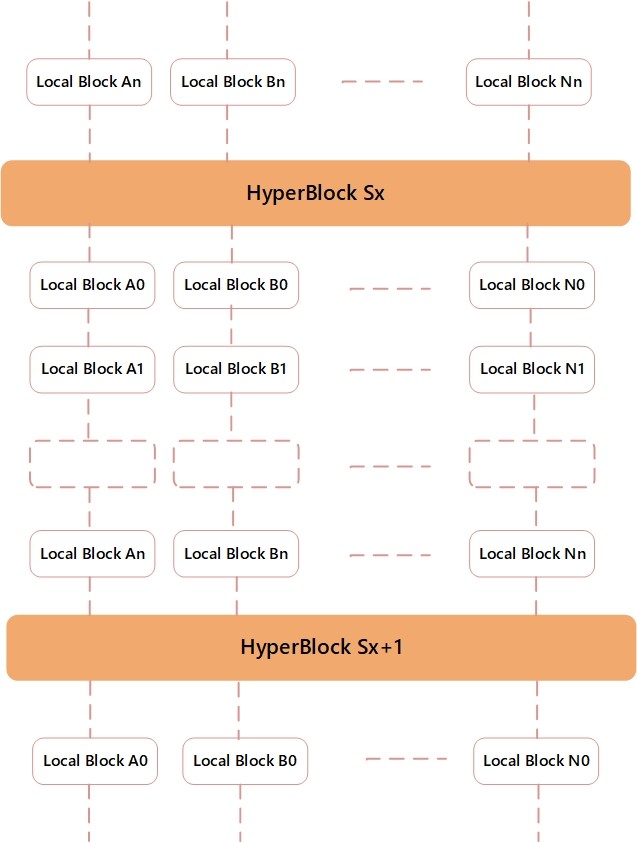
Figure 3 Paralism blockchain
The local block and the Hyper Block will be generated based on the former hash. The local block and Hyper Block that constitute the Paralism parallel structure cluster and generate data blocks by DPoW consensus protocol ,and each is anchored to the pre-order hash value, different sub-chains adopts differentLayer\space 2\space consensus to further increase the degree of the difficulty and realize the high consistency of the entire data structure.
2.4.2 DPoW Consensus
Hyperchain uses the Buddy consensus algorithm to attain and sustain the parallel structure chain. This algorithm draws on the implementation idea of Paxos algorithm, but has improved greatly, having avoided the implicit centralization that the algorithm may cause [18, 19], successfully decoupling the chain consensus from the application layer consensus. As the fundamental consensus algorithm for the chain layer, Buddy consensus does not explain application layer data, and does not depend on application layer services. Therefore, it is extremely flexible for supporting application layer consensus . In order to further enhance the anti-attack difficulty of the Buddy algorithm, yet not eventually becoming a “computing black hole” like the PoW algorithm, Paralism designs and implements the DPoW consensus algorithm. The DPoW algorithm makes good use of the parallel characteristics of the distributed system, completely avoids the power counter confrontation caused by zero-sum game in the PoW algorithm, and realizes the automatic adjustment of the calculation power of the whole network based on the Nash equilibrium condition, thus always maintaining the right level. It solves the problem of losing control of computing power caused by increasing difficulty of data attack resistance.
The consensus mechanism protocol adopted by Paralism is based on the buddy consensus-based consensus, and the distributed PoW mechanism is added, forming a joint function as Dpow -distributed proof of work . It mutually assists the adjustment of computing pow power in the implementation process of the consensus, to guarantee the supply of computing pow power. In the same time, the increase in data difficulty is proportional to the increase in total power in a cumulative manner.
{DPoW=f_{consen}(PoB,PoW,...)}
DPoW consensus reinforces the Pow algorithm characteristics in the Pow Buddy consensus algorithm, providing methodical support for participating nodes to more efficiently select other nodes to share computing and storage resources, and for resources stored on blockchain to have the corresponding difficulty protection. Providing proper categorization with convenience for the unique needs of different application scenarios of Paralism.
With this DPoW consensus mechanism, it is possible to classify and collect the participating nodes with different computational difficulty protection requirements, reduce blindness , improve the utilization efficiency of the participating nodes for shared resources, reduce the occupation of limited computing resources due to excessive low-quality applications, and increase participation effectiveness.
Based on DPoW consensus, the convenient support for the application consensus pluggability of Layer2, combined with the smart contract function supported by Paralism’s virtual machine, can provide the basic technology for self-contained coinage regarding asset management and other scenarios.
The complete process of DPoW consensus algorithm is as follows:
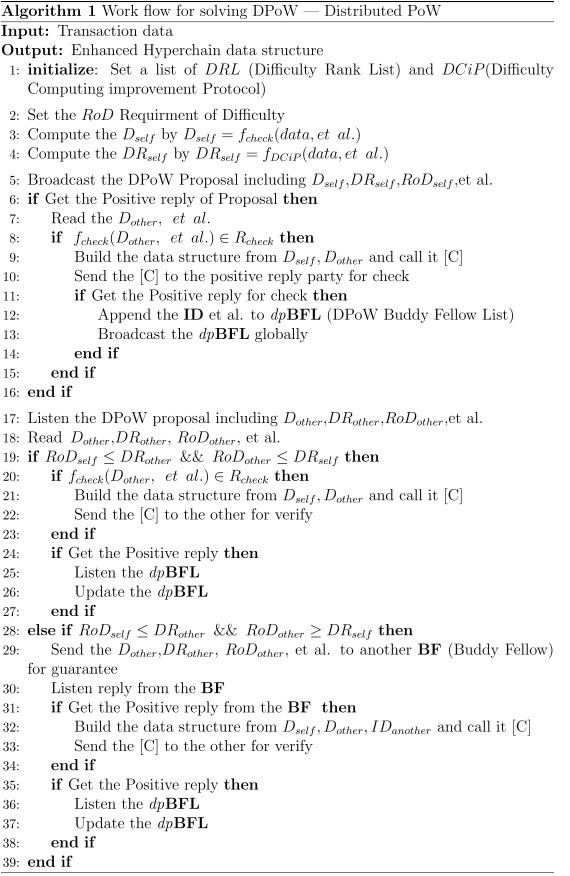
2.4.3 Dynamic Sharding Algorithm
One of the features of Paralism is how sub-chains can communicate with the Hyper Block periodically, allowing sub-chain shard or reduce according to customizable sharding mechanism. This way greatly improves the scalability of the blockchain catering to more different scenarios.
Hyper Block structure data is generated and combined according to the trigger requirement input by sub-chains in application settings. When the data load carried by the sub-chain exceeds the design scope, the sub-chain will perform data and transaction sharding according to DSiP (Dynamic Sharding Improvement Protocol); Until the next Hyper Block generation triggers the sharding mechanism, the load of data load is re-calculated based on DSiP. If the rule is satisfied, sharding is again performed ,or if the sub-chain meet the reduction condition after previous round, then sharding will be checked among each chains and be paused when necessary to avoid waste of resources.
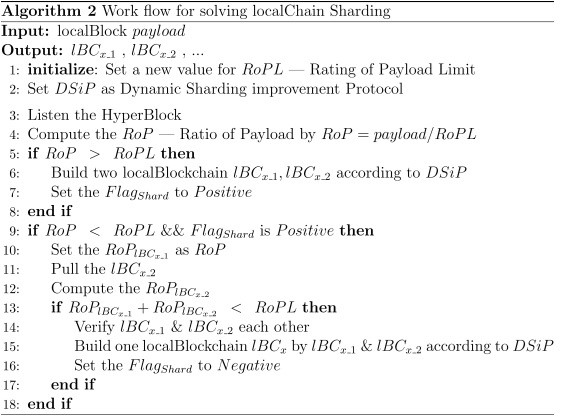
2.4.4 Cross-chain Protocol
Several types of cross-chain techniques have been come up with in the blockchain field, including notary schemes, side chains/relays and hash locks . The notary schemes inevitably contain the risk of centralization. The side chains/relays mechanism is inefficient due to the asynchronous feature,whereas the lock of hash does not support the multi-currency smart contract.
Based on Hyperchain technology, Paralism is naturally equipped with advantages of parallelly processing and cross-chain interaction. During the process of periodic Hyper Block generation by the sub-chains consisted of local blocks, they provide Hyper Block lock featured by basic features such as notarization and hash locking for cross-chain bridging and communication.
Based on the data structure of its own chain architecture, Paralism has developed Hyperchain based Inter-Operation implementation protocol to meet the requirements of all kinds of scenarios carried by parallel chains. The differences and characteristics between the blockchains are shown in the following table.
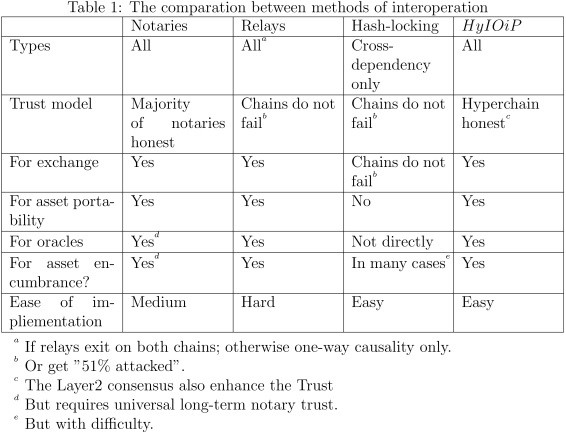
HyXiP protocol, combined with the advantages of periodical Hyper Block, can deliver the services including exchange among different sub-chains of Paralism carrying different assets or businesses, protocol extension or smart contract based on layer 2. The features are as shown in the above table which indicates many kinds of functions including atomicity.
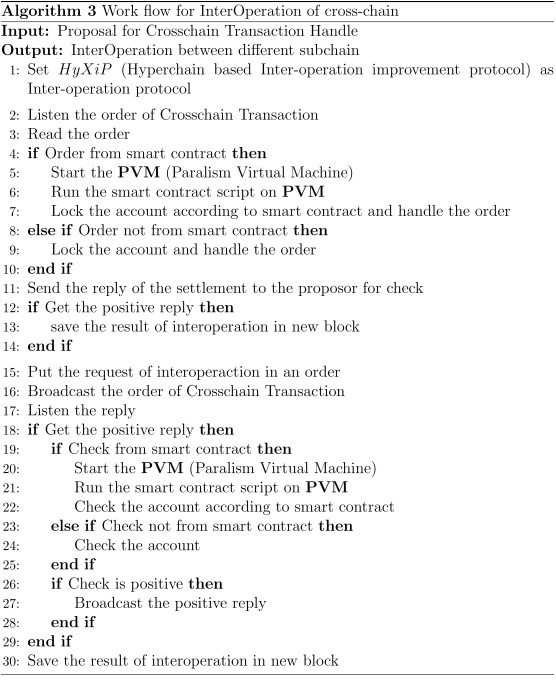
2.4.5 Analysis of Consistency Consensus
As a type of distributed system, blockchain also needs a consensus protocol as the operating mechanism standards, that being said, different consensus protocols will lead to different consistency effects. Distributed systems improve system reliability and fault tolerance by replicating data, and store different copies of data on different machines. Because of the high cost of maintaining data copies, many systems use weak consistency to improve performance. A number of different consistency models have also been proposed.
1)Strong consistency: Requires that regardless of which copy of the update operation is performed, all subsequent read operations must obtain the latest data.
2) Weak consistency: It takes a while for the user to read an operation to update the system-specific data. We call this period of time the “inconsistency window”.
3) Final Consistency: A special case of weak consistency ensuring that the user can eventually read the updates that certain operation brings to the specif data of the system.
The DPoW consensus is combination of PoB, PoW, and other Layer 2 application consensus. It combines the characteristics of PoB and PoW, but is dominated by PoB, so DPoW can be classified as the final consistency consensus.
PoB (Proof of Buddy) consensus algorithm with redundant fault tolerance. Although it cannot guarantee that all nodes are in the same state at a certain moment, it can guarantee that all nodes in the “final” stage are consistent. “The PoB consensus does not require the node to know all other nodes, so it is decentralized in that sense, the nodes are completely equal, and no central nodes are needed.
During the implementation of the DPoW Consensus, PoW is used to provide constraints for consensus participants, while PoB is used as leading mechanism for consensus participants to achieve systematic consistency.
2.5 Technical Characteristics and Advantages
Paralism inherits the advantages of Hyperchain in the basic architecture design, abandons the hard limitation of sequential data structure, and uses the parallel approach to deal with the consensus problem, thus solving the existing bottlenecks of current blockchain technology. In the meantime, Paralism adopted the strong-in-consistency PoW and other functions to strengthen the Buddy protocol and to form DPoW consensus mechanism, which is used to solve the problems such as poor performance caused by serialization, and the extension limitation of the consensus algorithm due to data on the chain. constrains of the type and expansion of data, power consumption, pseudo-decentralization, etc.Moreover, Paralism has built-in dynamic sharding and cross-chain trading solutions.
Paralism abandoned the common transaction-oriented design, but adopted a layered philosophy being widely used in the more extensive data processing procedure in Internet industry–chain layer and application layer will never block each other’s execution–providing pluggable consensus options for use cases involving assets. Paralism support the issuance of crypto currencies, does not rely on any specific ledger, nor execute reading of users’ data; it does not penetrate user’s data but to leave them to be fully processed by application layer allowing this layer to define its own data-based consensus script. With such design, Paralism provides higher flexibility to data processing. The on-chain data is not limited to specific ledger structure and the base currency transaction records giving equal status to on-chain data, and allowing the cp-existence of multiple ledgers and cryptos. Apart from the ledger generation and coin issuance at the application layer, the underlying chain of Paralism can retain reliability and stability just like traditional ledgers or cryptos. When running certain application consensus, another traditional blockchain can run parallelly in the virtual space of Paralism.
Paralism is totally decentralized which is determined by its consensus algorithm. In comparison, PoW algorithm is also perfectly decentralized, however, its computing power cost is quite considerable; PoS and PoS-ish algorithms do not have power waste problem, however, in fact, they give some nodes excessive power which will exert notable negative influence on the equality trait of Blockchain network[viii] . Algorithms of BFT category are simple and efficient. But, they severely destroy the decentralized characteristic of Blockchain and degrade to multi-centered system or just traditional central system. Additionally, they were designed to maintain a strong “consistency” under a “fault-tolerant” scenario. This is quite different from the genuine meaning of the word “consensus” in Blockchain. We consider that pre-setted “strong consistency” is a type of centralized fault-tolerance concept, not a consensus in a decentralized scenario and it is totally opposite to “decentralization”and “equality”. The ideology of Buddy Consensus of Hyperchain is similar to Paxos algorithm, but we have made a great improvement to remove the possibility of pre-setted “strong consistency” in Paxos algorithm to guarantee the overall equality in all participating nodes.
Paralism is designed with parallel principles. Meanwhile it achieves consensus algorithm extensibility by using different layers to manage consensus, therefore it can run multiple consensus on local chain at the same time and can support various digital currencies and ledgers as well. This feature provides a natural convenience for cross-chain operation. Cross-chain operation itself could be consolidated and serialized and can also provide a extra proof of credit. Hyperchain has a build-in cross-chain processing engine which can directly retrieve data from application layer and it can extends these operations at any time to accommodate more Blockchain interoperation.

Bitcoin, the pioneer of the first generation blockchain, implements the Turing incomplete machine mechanism; Ethereum is based on the former, and the Turing complete machine mechanism is implemented based on EVM. As the representative of the new generation of blockchain technology, Paralism realized cellular automation with parallel feature, which ultimately expands the application function and industrial prospects of blockchain.
3 Technical Solutions
3.1 Overall Architecture
Paralism is composed of a 4-layer architecture. The bottom of the system is physical layer. In the bottom-up order are Hyperchain layer, the PiP layer and the application layer.

CID – Coin Issuance of DIY
RDApp – Rapid DApp
Xop – Interoperation
VCh – Virtual Chain
PDE – Paralism Desktop Environment
PiP – Paralism improvement Protocol
PXC – Paralism Container
DSiP – Dynamic Sharding improvement Protocol
HyXiP – HyperBlock based inter operation improvement Protocol
HVM – HyperChain virtual Machine
HSDK – HyperChain Standard Development Kit
BCHost – BlockChain Hosting.
3.2 Device Layer
The computer operation base consisted of PC, laptop, tablet, server cloud and mobile phone ensures the necessary network equipment for running Paralism. According to different computing power or storage capacity of different devices such as PC, users can opt out to run the entire functions as full nodes, run partial node function, or even only run the part of interest.
3.3 Hyperchain Layer
According to the relevant implementation protocol of Hyperchain, the P2P network is constructed using Kad/DHT and other protocols to maintain data communication, storage operation database and file storage.. The parallel consistent algorithm of POB (Proof of Buddy) is used to construct the data block growth rule. HVM(Hyperchain Virtual Machine) is used to analyze and run scripts such as smart contracts, and HSDK (Hyperchain Standard Development Kit) is provided as script development support. BCHost is to support the chain space(BlockChain Hosting), which is maintained by all nodes. At the same time, the node does not have to maintain all the chain data, and only needs to retain part of the data that is meaningful or interesting to its own business. Redundant storage of chain data are shared among all nodes in the entire network. Last but not the least, Hyperchain layer provides the infrastructure with software layer basis on top of which Paralism operate with the support of relevant protocols.
3.4 PiP Layer
PiP layer is the consensus protocol and the driver layer for the operation protocol operation of Paralism. The blockchain layer implements different protocols according to the requirements of layer above, including DPoW consensus mechanism and the layer2 layer consensus of the specific business scenario, and execute the application script through the container mechanism of the PXC (Hyperchain Container). Different service-related protocols such as DSiP (Dynamic Sharding Mechanism Protocol) and HyIOiP (Hyper block-based Inter-operation protocol) are invoked according to the scenario.
PiP is the key layer of Paralism upon which the value of the whole parallel blockchain system sprout and grow.
3.5 Application Layer
According to the specific business needs of users, based on Paralism can users carry out independent coinage, rapid DApp development, cross-chain operation, virtual chain creation and PDE construction in other operating environments. It can be operated with different interfaces such as REST, RPC, CLI and API.
Users can choose Paralism’s existing consensus protocol or customized protocol mechanism to distribute the encrypted digital currency required by the business according to the specific scenario requirements. Users can also rapidly develop DApps according to specific application needs; Paralism is a parallel zone. On the digital economy platform supported by the blockchain, users can publish digital assets through a custom script on the sub-chain to
realize one-click coinage; users can use cross-chain protocols to cross-operate between different businesses on sub-chains of Paralism; Paralism Users can use the parallel multi-sub-chain characteristics of the system to develop their own “virtual chain” according as needed; in Paralism, users are also provided with PDE tools for operation and data observation of Paralism. In addition, with Paralism’s wide support for consensus protocols of Layer 2, users can issue different stable coins of different consensus or pegging mechanism to form a stable coin marketplace with sufficient liquidity.
4. Operation of Node and Application Deployment
4.1 Initialization and Node Establishment
4.1.1 Initialization and Node Establishment
After running Hyperchain application, nodes will try to detect and connect Bootstrap Server and other Hyperchain nodes via broadcast and inquire the nodes which accords with essential elements of genesis bloc in the received response packet. And the nodes will further request chain space information and confirm legal chain data and correspondent nodes by comparing the chain space information of different nodes sending back. When nodes accomplish the initialization of local chain space cache through above pressures, namely, node initialization is completed and nodes can start to join consensus block generating process at any time.
4.1.2 Consensus and Cheat Prevention
Based on the request of registering data on the chain Hyperchain joins the consensus. This behavior could be the self-need of a node or a certain agent behavior. The chain layer consensus process of Hyperchain do not explain user data, user data will be encapsulated as payload in a data package waiting for consensus processing. These data are encapsulated as payload in a data package waiting for consensus processing. As local data block, such data structure includes certified information including consensus script, public key etc. This local data block needs at least one other node peer( or peer group) to
validate in order to join a Local Chain consensus process. The validating process will check the consensus script and certified information between peers. The successful execution of the consensus script makes the two peers into a Buddy and the new Buddy starts to participate in a Local Chain consensus. After the Local Chain increases, it will execute the consensus script which has reached a Local Consensus. The scripts will validate users’ data by their customizable rules to ensure that the data will satisfy the consensus requirement. Such validating process will execute independently and it will not be impacted by any other nodes. A Local Consensus becomes acceptable only under the condition that over N/2+1 nodes have accepted this consensus. (N is the number of nodes joining the Local Chain consensus).
Local Chain grows on the exponential rate of 2n to increase the consensus scale and this will bring in a higher efficiency in detecting malicious nodes and invalid data to ensure the reliability of the Local Chain. Consensus script contains both Hyperchain default script and user defined script so that a user can freely choose the data validation methods according to user’s need in consensus process. POW, POS, BFT and other algorithms can provide additional validation information to reinforce data validation by bringing in computational difficulty or authorization methods. However, without any additional validation information, Hyperchain still can protect itself from the “51% attack of malicious nodes”.
4.1.3 Data Submission and Query
User data can be recorded on the Blockchain through joining Hyperchain consensus process. The data can be ledger, transaction record, certificate fingerprints or any other types of data. These data can be validated and consolidated by consensus scripts in the consensus process. Then they are distributively stored in all participated nodes, form a virtual chain space in the whole network and store all chain data. The chain data can be requested and queried by any node and could be searched and explored via Hyperchain Browser.
4.2 Coin Issuance of DIY
There are two types of digital currency issuance mechanisms as of now. One solidifies the total amount, issuance timeline in the system algorithm and will not change unless fork. The currency is decentralized in the system running process, such as Bitcoin. This kind of mechanism is called “Coinage”. The other sets the amount and issuance timeline in the agreement with the actual issuance agency. The public purchase the encrypted currency from the issuance agency and trade according the agreement. This type of encrypted digital currency is called Token.
Through the Paralism platform, user selects the system’s default or submits a customized consensus script to issue the encrypted digital currency of the user-specific business scenario, thereby reducing the difficulty of the distribution without affecting. the security. In other words, user can carry out Coin issuance DIY. This type of encrypted digital currency runs on a sub-chain defined by the user. The protocol mechanism used by the consensus script for encrypting digital currency can be PoW or PoS or others. The users set the total amount of currency issuance, the issuance mechanism, the issue period, the lockout period, etc. in the consensus script.
In addition, the user is also allowed to issue tokens in Paralism. Similarly to the digital currency issued with self-defined consensus script algorithm, issuers can control the digital currency allocation of the token during the entire process.
Users can set specific parameters of dynamic sharding according to business needs in Paralism, and outline conditions of cross-chain transactions, which can be run in PXC mechanism, PVM mechanism or user-defined manner.
4.3 RDapp (Rapid Decentralized App)
According to the specific business needs,Users can use different programming languages such as javascript to program on Paralism, to define specific consensus scripts, to construct DApps, and to form business-oriented specific sub-chains fully controlled by users, but at the same time, sharing common resources of the entire Paralism ecosystem. This especially fits ICO projects that pursues further on-chain operation.
If the user has established a DApp on a single-chain of sequential structure, the container mechanism of the PXC mechanism can also be utilized to implement rapid migration and replication deployment from a single-chain to a multi-chain environment through Paralism to meet the requirements of rapid response during actual operations.
4.4 Inter-operation And Decentralized Trade
Users of Paralism use the HyperXiP of the Hyper-blockchain cross-chain protocol,with the periodic Hyper block generation feature of the blockchain itself, to exchange between business assets or financial assets carried by different sub-chains of customers. The specific operation modes of the operation may be based on the Layer 2 extension protocol or the smart contract , etc. Smart contracts are executed in PVM after being interpreted. Users can set different conditions according to specific applications, and implement various functions including atomicity.
Based on the advantages of cross-chain operation, Paralism users can interact with different entities in different types of services between different sub-chains, regardless of whether the services carried by different sub-chains are account books or other asset classes, thus achieving decentralization trading.
4.5 Virtual Blockchain
For customers’ more special business needs, the virtualization mechanism of Paralism allows customers to virtualize a completely unrestricted custom chain structure in Payload, forming a logically exclusive “private chain” for users in any number of Payloads, which provides great business flexibility and reduces the cost of maintaining a custom chain from scratch. Therefore customers only need to select existing scripts or use the Javascript language to write the corresponding consensus scripts. You can choose the operating mechanism of PXC or PVM to form a private chain that the customer can control. The customer virtual chain can also set conditions for sharding and cross-chain operations while enjoying the entire resources of the Paralism ecosystem.
Unlike the so-called “virtual chain” in which projects such as Fabric run on the public cloud, Paralism provides a “light resource” type of functional blockchain at the user application level rather than a “heavy chain” with full resource requirements in the public cloud.
4.6 Stable Coin Market
The stable currency generally refers to the issuance of currency with guarantee by the digital currency issuer according to certain rules. The issuer may reserve the corresponding amount of equivalents for the risk stabilization guarantee according to the issue amount. The equivalent may be the specific central bank legal currency, gold or some portfolio in order to make sure all circulates digital currencies pegged to corresponding collateral.
Paralism’s multi-sub-chain parallel and interoperable natural features provide a complete venue for the issuance of stable coins. The stable currency issued by any sub-chain can be operated in parallel with other sub-chain digital currencies or other tokens. In addition to anchoring to fiat currency, it can also anchor the digital currency of other sub-chains or valuable digital assets at the same time, thus providing a richer anchor for the issuance of stable coins, and also provides a broad application for stable currency issuance
Users can choose to have a system-specific or design-specific consensus mechanism to issue an encrypted digital stable currency that meets customer needs. The customer can set the total amount of the issued digital currency, the release tempo, the unlocking period, etc., configure the specific amount of the target anchoring currency and its ratio, and write the parameters such as the sharding adjustment and the cross-chain transfer operation in the language of javascript.etc. into the script. After the completion of programming and interpreting, the script then run in PVM or PXC mode under sand box mechanism .
Encrypted digital stable currency and other digital currencies together constitute the digital cryptocurrency in the Paralism ecosystem. With different digital crypto-currencies in the ecology and the function of cross-chain trading , various digital currency are directly or indirectly linked to actual fiat or assets. The different stable currencies in the Paralism eventually form a stable currency marketplace propelling free launch, purchase and exchange of stable coins.
5 Conclusion
Paralism expands the advantage of parallel Hyperchain technology. The DPoW algorithm enhances the economic factors and mathematical anti-attack difficulty in the Buddy consensus algorithm. Dynamic Sharding fully exploits the scalability of the parallel architecture and brings dynamic load capacity. These greatly improve the economic efficiency of Hyperchain technology, with features such as templated deployment and virtual chain, so that Paralism can achieve unforgettable business adaptability at the application layer. Paralism is a completely decentralized, unprivileged node’s public chain, also supports multiple consensuses at the application layer and is independent of each other. Therefore, it can support any federation chain technology to run in a sub-chain mode, so that Paralism has advantage of both public chains and alliance. Paralism can fully support the issuance of coins, and at the same time support a variety of coin coexistence, but also support Token distribution and various types of non-coin business. Shockingly, all of which can be done in a decentralized way in the chain Operation, thus inter-operating for various types of assets, including digital currency, warrants, physical asset mapping, etc to achieve true value of interconnection.
Paralism has fundamentally implemented the technical content of the white paper. Paralism will continue to optimize key parameters and strengthen and improve the development of virtual machines, user-defined consensus parts. Some exciting features new will be released continuously. Thank you for your attention, welcome to join us!
6 References
[1].Technical White Paper of Hyperchain,https://www.Hyperchain.net/blog/archives/940
[2] .Kyle Croman. On Scaling Decentralized Blo ckchains. J. Clark e t al. (Eds.): FC 2016 Workshops, LNCS 9604, pp. 106–125, 2016.
[3] .TradeBlock. Bitcoin network capacity analysis. https://tradeblock.com /blog/bitcoin-network-capacity-analysis-part-1-macro-block-trends
[4]. Wenting Li, Alessandro Sforzin, et al. , Towards Scalable and Private Industrial Blockchains, https://www.ghassankarame.com/BCC17_Blockchain.pdf
[5]. Hoang Tam Vo, Ashish Kundu, Mukesh Mohania, Research Directions in Blockchain Data Management and Analytics, http://openproceedings.org/2018/conf/edbt/paper-227.pdf
[6] . European Union, Futurium, Next Generation Internet. 2016-11. https://ec.europa.eu/futurium/en/content/bitcoin-blockchain-and-future-internet
[7] . https://www.bitcoin.com/info/bitcoin-what-is-it-and-why-is-it-important
[8]. Difference Between ICO, IEO and STO , https://kodorra.com/difference-between-ico-ieo-and-sto/
[9]. Initial Exchange Offering: How is an IEO Different than an ICO?, https://bitcoinexchangeguide.com/initial-exchange-offering-how-is-an-ieo-different-than-an-ico/
[10] How Institutional Investors Are Changing The Cryptocurrency Market https://www.forbes.com/sites/andrewarnold/2018/10/19/how-institutional-investors-are-changing-the-cryptocurrency-market/#1600baf81ffe
[11]. ICO vs STO: Are Security Token Offerings (STOs) Banned in China?, https://smartereum.com/45188/ico-vs-sto-are-security-token-offerings-stos-banned-in-china/
[12]. Ling Ren, Srinivas Devadas, Bandwidth Hard Functions for ASIC Resistance, https://eprint.iacr.org/2017/225.pdf
[13] .Marko Vukolic, IBM Research – Zurich, The Quest for Scalable Blockchain Fabric:Proof-of-Work vs. BFT Replication. iNetSec 2015.
[14] Research: EOS is not a blockchain, it’s a glorified cloud computing service,https://thenextweb.com/hardfork/2018/11/01/eos-blockchain-benchmark/
[15] A Digital Economic Platform Supported by Parallel Blockchain Technology, Paralism Commercial White Paper, https://www.paralism.com/blog/paralism-commercial-white-paper/
[16] .Sunny King, Scott Nadal(2012), PPCoin: Peer-to-Peer Crypto-Currency with Proof-of-Stake
[17]Fredrik Jansson, Oskar Petersen, Blockchain Technology in Supply Chain Traceability Systems, LU Engineering Logistics, Master’s Thesis, Spring 2017
[18] .Lamport, Leslie (2001). Paxos Made Simple ACM SIGACT News (Distributed Computing Column) 32, 4 (Whole Number 121, December 2001) 51-58.
[19] .Andrew Poelstra. “Distributed Consensus from Proof of Stake is Impossible”, https://download.wpsoftware.net/bitcoin/pos.pdf

